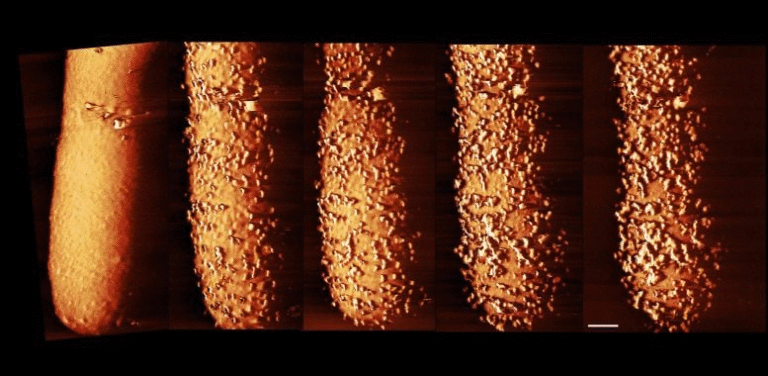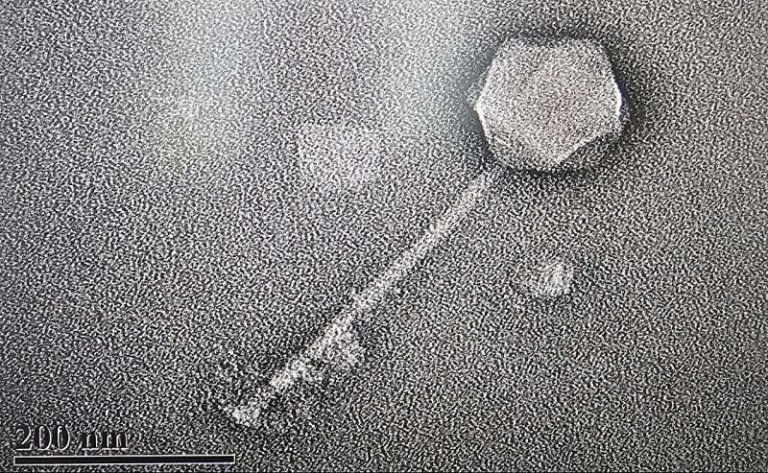167-Million-Year-Old Reptile With Snake-Like Jaws Found in Scotland Redefines What We Know About Early Lizards

A remarkable new discovery from Scotland’s Isle of Skye has revealed a 167-million-year-old reptile that blurs the traditional boundaries between snakes and lizards. Named Breugnathair elgolensis, which means “false snake of Elgol” in Gaelic, this ancient species is forcing scientists to rethink how these two reptile groups evolved.
The fossil, found in rocks dating back to the Middle Jurassic period, shows a combination of traits that don’t fit neatly into any known category. It has snake-like jaws and curved, hook-shaped teeth, yet retains a short body, fully developed limbs, and lizard-like proportions. This strange mixture makes Breugnathair one of the most puzzling prehistoric reptiles ever found.
Discovery on the Isle of Skye
The story of Breugnathair began in 2016, when Stig Walsh from the National Museums Scotland uncovered the fossil during an expedition with paleontologist Roger Benson and other researchers. The specimen was found in the Kilmaluag Formation, a geologic layer that preserves fossils from the Bathonian stage of the Middle Jurassic, around 167 million years ago.
The Kilmaluag Formation is known for its lagoonal and estuarine sediments — an environment that was once a mix of shallow seas, tidal flats, and freshwater influences. It’s a treasure trove for Jurassic life, revealing early mammals, amphibians, and reptiles from a time when the British Isles were part of a warm, subtropical landscape.
The fossil, catalogued as NMS G.2023.7.1, was found disarticulated — meaning the bones weren’t connected but scattered in a block about 19 centimeters across. Even so, the team confirmed that all the remains belonged to a single individual, based on the matching morphology and symmetry of the bones.
This find has been over a decade in the making. The researchers used high-resolution CT scanning and synchrotron X-ray imaging at the European Synchrotron Radiation Facility in Grenoble, France, to visualize the internal structures without damaging the fossil. This intensive work revealed an animal unlike any seen before.
A Mosaic of Features: Part Snake, Part Lizard
Breugnathair elgolensis stands out for its “mosaic anatomy” — a blend of features from different reptile lineages. Its teeth are deeply curved and recurved backward, like the fangs of modern pythons, designed to grip struggling prey. The jaws show snake-like mobility, allowing a wider gape than typical lizards.
However, the rest of the skeleton tells a different story. Breugnathair had a stout, short body, complete with fully formed limbs and a typical lizard-like skull structure. This indicates it wasn’t in the process of losing limbs, like early snakes were, but had independently evolved similar jaw features for hunting.
The teeth sit in shallow sockets and are separated by small ridges — a primitive arrangement for squamates (the group that includes all lizards and snakes). In some ways, its cranial bones resemble those of geckos and varanids (monitor lizards), yet other parts appear far more ancient, showing traits from early squamate ancestors.
This peculiar mix of modern and primitive features has led researchers to place Breugnathair in a newly defined extinct group called the Parviraptoridae. Before this discovery, parviraptorids were known only from incomplete bones and fragments, leaving scientists unsure of their identity. Breugnathair provides the first nearly complete look at one of these elusive reptiles.
A Predator of the Jurassic Ecosystem
At about 41 centimeters (16 inches) from head to tail, Breugnathair was one of the largest lizards of its ecosystem. It likely preyed on smaller reptiles, early mammals, amphibians, and perhaps even juvenile dinosaurs.
Its hooked teeth and flexible jaws suggest it could grasp and restrain slippery or struggling prey — a trait we associate with snakes, but in this case, part of a distinct evolutionary experiment.
The Middle Jurassic period was a time when modern reptile groups were just beginning to diversify. Crocodilians, turtles, and early mammals shared their environments with an array of lizards, amphibians, and dinosaurs. In this setting, Breugnathair would have been a stealthy predator in a world still dominated by giants.
What This Means for Snake Evolution
Lizards and snakes belong to a larger order called Squamata, which today includes over 11,000 species. But understanding when and how snakes branched off from lizard-like ancestors has long been a challenge.
Breugnathair has added both clarity and confusion to this question. Phylogenetic analysis (the study of evolutionary relationships) suggests that Parviraptoridae, the group to which Breugnathair belongs, could be either:
- Early members of the snake lineage (snake stem group), or
- Stem squamates — reptiles that evolved before the true split between snakes and lizards.
Depending on how the data are interpreted, either hypothesis could be true. If Breugnathair is indeed a snake ancestor, it may show that snake-like jaws evolved before limb loss. But if it’s not, it suggests that snake-like features evolved multiple times in different squamate lineages — a striking example of convergent evolution.
Either way, this discovery underscores how complex and non-linear evolution can be. Features like fanged jaws, recurved teeth, and wide-gaping skulls may have appeared in multiple reptile lineages, each adapting to similar predatory lifestyles.
The Fossil’s Scientific Significance
The research team, which included scientists from the American Museum of Natural History, University College London, National Museums Scotland, University of Cambridge, and institutions in France and South Africa, described Breugnathair as one of the oldest and most complete fossil lizards ever found.
This completeness is crucial. For decades, paleontologists had only bits and pieces of early squamate fossils — tooth-bearing bones, fragments of jaws, and vertebrae — making it difficult to trace the order’s origins. Breugnathair provides the “missing top of the jigsaw box,” helping connect these scattered pieces into a coherent picture.
The study emphasizes that early squamates were experimenting with anatomy. There wasn’t one single “path” from lizard to snake, but a web of diverse and overlapping lineages, many of which didn’t survive.
Breugnathair’s combination of primitive bones and advanced feeding adaptations captures a moment in this experimentation — a rare glimpse into how reptiles were evolving new strategies for survival and predation during the Jurassic.
A Decade of Work Behind the Scenes
After its discovery in 2016, the fossil underwent years of delicate preparation. Researchers carefully removed surrounding rock, imaged the bones using computed tomography (CT), and analyzed them using high-powered X-rays at the European Synchrotron facility.
These non-destructive imaging techniques allowed scientists to see inside the fossil in three dimensions, revealing fine details of the skull, teeth, and jaw structure that would otherwise remain hidden.
The effort paid off — the resulting dataset became the foundation for the Nature paper published on October 1, 2025, titled “Mosaic anatomy in an early fossil squamate.”
The research was supported by several organizations, including the National Research Foundation of South Africa, the DSTI-NRF Centre of Excellence in Palaeosciences, and the Palaeontological Scientific Trust.
Understanding Squamates: The Broader Context
To fully appreciate the importance of Breugnathair, it helps to understand what squamates are. The order Squamata includes all living lizards, snakes, and amphisbaenians (worm lizards). Together, they represent the largest order of reptiles today.
Squamates are defined by their scaly skin, flexible skulls, and kinetic jaws — traits that have made them incredibly adaptable. Their evolutionary origins trace back to the Triassic period, over 240 million years ago, but fossils from their earliest phases are rare and fragmentary.
This is what makes discoveries like Breugnathair so valuable. They help fill the evolutionary gap between ancient reptile groups and the squamates that dominate today’s ecosystems.
Early squamates likely evolved from diapsid reptiles — animals with two temporal openings in their skulls — giving rise to modern lizards and snakes through gradual adaptation. But the exact sequence of traits that led to snakes’ limbless, elongate bodies remains a subject of debate.
Breugnathair doesn’t answer every question, but it adds a crucial data point: snakes may have inherited some of their defining feeding mechanisms long before losing their limbs.
The Environment of the Kilmaluag Formation
The Kilmaluag Formation, where the fossil was found, is a well-known site for Jurassic fossils in the Inner Hebrides of Scotland. It’s part of the Great Estuarine Group, composed of limestone, mudstone, and sandstone layers that were laid down in coastal lagoons and estuaries.
During the Middle Jurassic, this region would have been a humid, subtropical landscape, home to early crocodiles, small dinosaurs, amphibians, and the ancestors of modern lizards and mammals.
The presence of Breugnathair in this ecosystem suggests that predatory squamates were already well-established by this time — a reminder that key evolutionary innovations were happening far earlier than once thought.
Why It Matters
Breugnathair elgolensis isn’t just another fossil; it’s a window into an era of rapid evolutionary experimentation. It reminds us that nature doesn’t follow a single blueprint. Instead, evolution tests multiple possibilities — sometimes more than once.
By uncovering species like this “false snake,” scientists can reconstruct not only how snakes evolved, but also how complex features like flexible jaws and recurved teeth emerged through adaptation and convergence.
It also highlights the global importance of the Isle of Skye for paleontology. Few places offer such well-preserved fossils from the Middle Jurassic — a period that remains one of the most mysterious chapters in vertebrate evolution.
Reference:
“Mosaic anatomy in an early fossil squamate” – Nature (2025)





